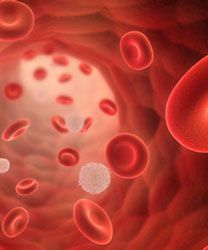Ibrutinib/Buparlisib Induces Responses in Half of NHL Cohort
An objective response rate was achieved in 18 of 37 patients with relapsed/refractory non-Hodgkin lymphoma who received the combination of the BTK inhibitor ibrutinib with the PI3K inhibitor buparlisib, according to findings of a phase I/II trial reported at the 2018 ASCO Annual Meeting.

An objective response rate was achieved in 18 of 37 patients with relapsed/refractory non-Hodgkin lymphoma (NHL) who received the combination of the BTK inhibitor ibrutinib (Imbruvica) with the PI3K inhibitor buparlisib, according to findings of a phase I/II trial reported at the 2018 ASCO Annual Meeting.
Of the responding patients, the greatest benefit was reported in patients with mantle-cell lymphoma (MCL), of whom 13 of 18 patients had objective responses with ibrutinib/buparlisib. The combination had less robust activity in patients with relapsed/refractory diffuse large B-cell lymphoma (DLBCL) and follicular lymphoma (FL).
The regimen was associated with the expected toxicities common to BTK inhibition and PI3K inhibition, Bonnie Lee Batlevi, MD, a lymphoma specialist at Memorial Sloan Kettering Cancer Center, and colleagues reported.
“Promising efficacy is observed in mantle cell lymphoma,” they concluded in a poster presentation. “Cell free DNA analysis during therapy is feasible and demonstrates potential to evaluate tumor evolution.”
Single-agent buparlisib and ibrutinib are active in DLBCL, MCL, and FL. In vitro studies provided evidence of synergy with the combination of BTK and PI3K inhibition in NHL. Batlevi and colleagues evaluated the combination in a phase I/Ib dose escalation/expansion trial involving patients with relapsed/refractory DLBCL, MCL, and FL.
Eligible patients had relapsed/refractory DLBCL, more than 1 prior line of therapy, and had received, declined, or were ineligible for autologous stem-cell transplant; MCL and more than 1 prior line of therapy; or FL and more than 2 prior lines of therapy. Next-generation sequencing of the baseline tumor was performed when tissue was available, and serial cell free DNA analysis was performed before and after treatment.
Patients received ibrutinib and buparlisib daily throughout 28-day cycles. Dose reduction was permitted after cycle 1 in the absence of dose-limiting toxicity. Restaging occurred at 8 weeks (2 cycles of therapy) until cycle 13, then every 12 weeks thereafter. The maximum-tolerated dose level was 560 mg of ibrutinib and 80 mg of buparlisib.
Investigators enrolled a total of 37 patients: 18 with MCL, 14 with DLBCL, and five with FL. The study population had a median age of 70 (range, 48-84), 27 of the patients were male, and 10 were female.
The MCL group had received a median of 1 (range, 1-3) prior line of therapy, 6 had undergone ASCT, and 1 had an allograft. The median Mantle-cell International Prognostic Index (IPI) score was 6.3 (range, 4.97-9.30).
Ten of the 14 patients with DLBCL had de novo disease. They had a median of 3 (range, 1-7) prior lines of therapy. Four had undergone ASCT and 1 an allograft. Seven had germ center B-cell disease and 7 had other forms. The group had a median IPI score of 4 (range, 2-6).
The FL group had median treatment history of 2 prior lines of therapy, 2 had undergone ASCT, and the median FLIPI score was 3 (range, 2-5).
The 18 objective responses in the overall population, comprised 16 complete responses and 2 partial responses. An additional 3 patients had stable disease. By individual disease type, 13 of 18 with MCL responded to the treatment (12 complete responses); 4 of 14 with DLBCL (3 complete responses); and 1 of 5 patients with FL had a complete response and 3 others had stable disease.
The median time to response was 1.7 months (range, 1.6-2) among patients with MCL and 2.1 months (range, 1.6-11.8) among those with DLBCL.
Grade ≥3 treatment-related adverse events (TRAEs) occurred in 61% of the patients, the most common being hyperglycemia, diarrhea, elevated bilirubin, thrombocytopenia, fatigue, and liver enzyme (ALT) elevation.
Lipase elevation occurred in about 30% of patients but was not associated with radiologic or clinical pancreatitis, the investigators reported. Cytomegalovirus (CMV) reactivation occurred in 11% of patients, but none required CMV-directed treatment. Seven patients had neurologic adverse events, consisting of mood change, depression, anxiety, amnesia, and confusion. All neurologic events were reversible with discontinuation of buparlisib.
Ibrutinib dose reduction was required in 35% of patients and buparlisib dose reduction in 41%. From 75% to 80% of patients required dose interruption for both drugs; 44% of patients had ibrutinib dose interruptions lasting at least 7 days, and 69% of patients had such interruptions with buparlisib.
Reference:
Batlevi CL, De Frank S, Stewart C, et al. Phase I/II clinical trial of ibrutinib and buparlisib in relapsed/refractory diffuse large B-cell lymphoma, mantle cell lymphoma, and follicular lymphoma.J Clin Oncol. 2018;36 (suppl; abstr 7520).
Examining the Non-Hodgkin Lymphoma Treatment Paradigm
July 15th 2022In season 3, episode 6 of Targeted Talks, Yazan Samhouri, MD, discusses the exciting new agents for the treatment of non-Hodgkin lymphoma, the clinical trials that support their use, and hopes for the future of treatment.
Listen








